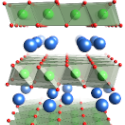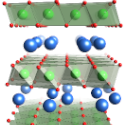Surprises from NMR in sodium cobaltates
A large part of the interest in superconducting is that the layers are reminiscent of the layers in high- cuprates, except that the ions sit on a triangular lattice, which enhances the role of magnetic frustration between the Co spins. Also like the cuprates, the layered cobaltate displays a rich medley of ordered states: superconductivity when intercalated with water for , insulating charge-order at , and spin-density wave order at . The insulating state at separates two distinct metallic states: a paramagnetic metal below and a “Curie-Weiss” metal with antiferromagnetically coupled spins above .
While no consensus exists on a theoretical picture, this experimental phase diagram is generally believed to be true. Now, Guillaume Lang and colleagues from Laboratoire de Physique des Solides at Université Paris-sud and Laboratoire Léon Brillouin in Saclay report a rather different phase diagram based on nuclear magnetic resonance experiments. Writing in Physical Review B, the authors find that at low temperatures there exists a critical doping range, 0.63–0.65, below and above which antiferromagnetic and ferromagnetic correlations are, respectively, dominant. This contradicts the nonmagnetic behavior reported earlier for .
For , Lang et al. also identify a doping-dependent temperature scale , which separates a high-temperature region with ferromagnetic correlations and a low-temperature region with antiferromagnetic correlations. The line slopes away from the insulating limit ( ) in the same way the pseudogap crossover line does in the cuprates. The physical origin of this doping- and temperature-dependent crossover in magnetic correlations is a striking new puzzle for theory to address. – Sarma Kancharla





